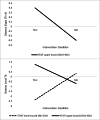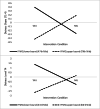Effects of prenatal mindfulness-based childbirth education on child-bearers' trajectories of distress: a randomized control trial
- PMID: 33059638
- PMCID: PMC7559171
- DOI: 10.1186/s12884-020-03318-8
Effects of prenatal mindfulness-based childbirth education on child-bearers' trajectories of distress: a randomized control trial
Abstract
Background: The perinatal period is a time of immense change, which can be a period of stress and vulnerability for mental health difficulties. Mindfulness-based interventions have shown promise for reducing distress, but further research is needed to identify long-term effects and moderators of mindfulness training in the perinatal period.
Methods: The current study used data from a pilot randomized control trial (RCT) comparing a condensed mindfulness-based childbirth preparation program-the Mind in Labor (MIL)-to treatment as usual (TAU) to examine whether prenatal mindfulness training results in lower distress across the perinatal period, and whether the degree of benefit depends on child-bearers' initial levels of risk (i.e., depression and anxiety symptoms) and protective (i.e., mindfulness) characteristics. Child-bearers (N = 30) in their third trimester were randomized to MIL or TAU and completed assessments of distress-perceived stress, anxiety, and depressive symptoms-at pre-intervention, post-intervention, six-weeks post-birth, and one-year postpartum.
Results: Multilevel modeling of distress trajectories revealed greater decreases from pre-intervention to 12-months postpartum for those in MIL compared to TAU, especially among child-bearers who were higher in anxiety and/or lower in dispositional mindfulness at baseline.
Conclusions: The current study offers preliminary evidence for durable perinatal mental health benefits following a brief mindfulness-based program and suggests further investigation of these effects in larger samples is warranted.
Trial registration: The ClinicalTrials.gov identifier for the study is: NCT02327559 . The study was retrospectively registered on June 23, 2014.
Keywords: Childbirth; Distress; Mindfulness; Postpartum depression.
Conflict of interest statement
LGD holds an unpaid position as board member of the Mindful Birthing and Parenting Foundation. The other authors declare that they have no competing interests.
Figures



Similar articles
-
Benefits of preparing for childbirth with mindfulness training: a randomized controlled trial with active comparison.BMC Pregnancy Childbirth. 2017 May 12;17(1):140. doi: 10.1186/s12884-017-1319-3. BMC Pregnancy Childbirth. 2017. PMID: 28499376 Free PMC article. Clinical Trial.
-
'I've Changed My Mind', Mindfulness-Based Childbirth and Parenting (MBCP) for pregnant women with a high level of fear of childbirth and their partners: study protocol of the quasi-experimental controlled trial.BMC Psychiatry. 2016 Nov 7;16(1):377. doi: 10.1186/s12888-016-1070-8. BMC Psychiatry. 2016. PMID: 27821151 Free PMC article.
-
An evaluation of mindfulness-based childbirth and parenting courses for pregnant women and prospective fathers/partners within the UK NHS (MBCP-4-NHS).Midwifery. 2018 Sep;64:1-10. doi: 10.1016/j.midw.2018.05.004. Epub 2018 May 26. Midwifery. 2018. PMID: 29843001
-
[Benefits of mindfulness in pregnant women].Medicina (B Aires). 2020;80 Suppl 2:47-52. Medicina (B Aires). 2020. PMID: 32150713 Review. Spanish.
-
Pregnancy and the perinatal period: The impact of attachment theory.Psychiatriki. 2020 Jul-Sep;31(3):257-270. doi: 10.22365/jpsych.2020.313.257. Psychiatriki. 2020. PMID: 33099466 Review.
Cited by
-
Enhancing Prenatal Group Medical Visits with Mindfulness Skills: A Pragmatic Trial with Latina and BIPOC Pregnant Women Experiencing Multiple Forms of Structural Inequity.Mindfulness (N Y). 2024 Dec;15(12):2975-2994. doi: 10.1007/s12671-023-02227-z. Epub 2023 Oct 10. Mindfulness (N Y). 2024. PMID: 40151662 Free PMC article.
-
Effects of maternal psychological distress and perception of COVID-19 on prenatal attachment in a large sample of Italian pregnant women.J Affect Disord. 2021 Dec 1;295:665-672. doi: 10.1016/j.jad.2021.08.102. Epub 2021 Sep 4. J Affect Disord. 2021. PMID: 34509782 Free PMC article.
-
Improving maternal well-being: a matrescence education pilot study for new mothers.Matern Health Neonatol Perinatol. 2025 Jul 2;11(1):18. doi: 10.1186/s40748-025-00203-0. Matern Health Neonatol Perinatol. 2025. PMID: 40598619 Free PMC article.
-
The relational dimension in mindfulness intervention effects: results of a randomized controlled trial of mindfulness-based childbirth and parenting.BMC Pregnancy Childbirth. 2025 May 10;25(1):560. doi: 10.1186/s12884-025-07676-z. BMC Pregnancy Childbirth. 2025. PMID: 40348986 Free PMC article. Clinical Trial.
-
Cumulative adversity, mindfulness, and mental health in first-time mothers experiencing low income.J Affect Disord Rep. 2023 Dec;14:100621. doi: 10.1016/j.jadr.2023.100621. Epub 2023 Jun 28. J Affect Disord Rep. 2023. PMID: 40823367 Free PMC article.
References
Publication types
MeSH terms
Associated data
LinkOut - more resources
Full Text Sources
Medical

